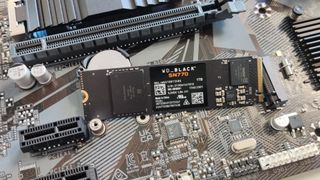As Microsoft rolls out its Windows 11 24H2 update, owners of certain Western Digital SSDs have been greeted with constant Blue Screens of Death
Has there ever been a major Windows update that hasn't messed up something somewhere?

Another Windows update, another round of users complaining about crashes and bugs. While hardly news, this time around the fault is very specific but also very annoying, and it concerns Western Digital SSDs, specifically its SN770 and SN580 models. It seems that these drives just aren't ready for the 24H2 update and the result is a glut of crashes and infamous Blue Screens of Death (BSODs).
All of these troubles were flagged up by SN770/SN580 owners on Western Digital's community forums (via TechSpot). It looks like the problem revolves around something called the Host Memory Buffer (HMB). All SSDs store a map of where data is located within its flash memory chips and this constantly gets updated, as information gets deleted and added.
Some SSDs have a single DRAM module on them and store the map in that, but many gaming SSDs are DRAM-less (to reduce the price tag) and instead, store this map in a little bit of the PC's system memory. This is called the HMB and without it, performance takes a hit when doing lots of little writes and erases.
From what WD SSD owners have been saying, it would seem that the WD Black SN770 and Blue SN580 stick to a maximum HMB size of 64 MB but in the 24H2 update, Windows increases this to 200 MB. The SSD's firmware doesn't like this figure and the result is all the errors.
Current solutions involve delving into Window's registry and heading to the Computer\HKEY_LOCAL_MACHINE\SYSTEM\CurrentControlSet\Control\StorPort section. For SN770/SN580 owners, there should be an entry labelled HMBAllocationPolicy and all one needs to do is set the value to zero and then reboot. This disables the use of the HMB but it does apparently cure the problem.
However, other forum visitors suggest a value of 2 works for them. Some users just used Windows' rollback feature to return the operating system to its previous 23H2 status. The real solution, of course, requires a fix from Microsoft and/or an updated firmware from Western Digital for those SSDs.
What's interesting is that there is a large number of other SSD models out there that also use a 64 MB size HMB but as of yet, I've not seen any complaints about Windows bailing out on those drives. I'm not suggesting this is all Western Digital's fault because one thing we don't know is if Microsoft made it clear to all SSD vendors that the default HMB size would be changed in 24H2.
The biggest gaming news, reviews and hardware deals
Keep up to date with the most important stories and the best deals, as picked by the PC Gamer team.
The 24H2 update is being slowly rolled out at the moment, so not everyone has the choice to install it yet. But if you do own a WD SN770 or SN580 SSD, then I strongly recommend you wait until Western Digital releases a new firmware fix for its drives.
Windows 11 review: What we think of the latest OS.
How to install Windows 11: Guide to a secure install.
Windows 11 TPM requirement: Strict OS security.

Nick, gaming, and computers all first met in 1981, with the love affair starting on a Sinclair ZX81 in kit form and a book on ZX Basic. He ended up becoming a physics and IT teacher, but by the late 1990s decided it was time to cut his teeth writing for a long defunct UK tech site. He went on to do the same at Madonion, helping to write the help files for 3DMark and PCMark. After a short stint working at Beyond3D.com, Nick joined Futuremark (MadOnion rebranded) full-time, as editor-in-chief for its gaming and hardware section, YouGamers. After the site shutdown, he became an engineering and computing lecturer for many years, but missed the writing bug. Cue four years at TechSpot.com and over 100 long articles on anything and everything. He freely admits to being far too obsessed with GPUs and open world grindy RPGs, but who isn't these days?
Most Popular






